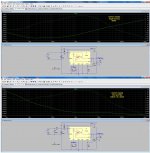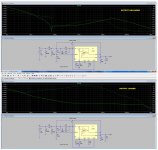When doing these simulations, the first electrolytic capacitor (connected to the voltage source) is useless except if you define some series resistance of this voltage source, just try 🙂.
Of course in the real life the things are different...
I'm not sure what change you mean. If possible add it to the asc file for me to see or show it how.
BTW, I do not see any kind of load on the first picture?
Of course, there will always be a load. Load added. Curve got much flatter.
Can someone explain to me why the resistor divider is at the input on the datasheet and at the output on the DIYINHK version?
Here are some more PSRR comparisons. The CRC improvement seems quite obvious all over. Anything against it?
No differences between PSRR on datasheet and DIYINHK versions. I would have to check any impedance differences.
The more components that can be eliminated to simplify the circuit the better.
Please do suggest changes to correct or to improve things.
Attachments
Since you use the High-power version, load it accordingly, for example with 15 ohm load which yield 1.5A output current.
The resistor dividers are not so important for PSRR simulations - they are used by Enable and Power Good circuitries.
Very high values for resistor in the input CRC filter are not advisable because you'll loose a lot of voltage over it, especially with high currents.
The resistor dividers are not so important for PSRR simulations - they are used by Enable and Power Good circuitries.
Very high values for resistor in the input CRC filter are not advisable because you'll loose a lot of voltage over it, especially with high currents.
Since you use the High-power version, load it accordingly, for example with 15 ohm load which yield 1.5A output current.
I just checked on the preamps I would be using these regulators, and the maximum load and current demand would be 50mA, according to the simulation.
How much can load it with and not need the external transistor?
Would I need a small heatsink on the 3042? According to my numbers, for 3v x 0.05A = 150mW.
The resistor dividers are not so important for PSRR simulations - they are used by Enable and Power Good circuitries.
Can you explain a bit more on that? Can or should I eliminate them?
Very high values for resistor in the input CRC filter are not advisable because you'll loose a lot of voltage over it, especially with high currents.
The load I'm using now shows the maximum demand I would be, and in fact the drop is almost 2v.
Lowering the CRC resistor to 10 ohms will sacrifice 5dB, which I think is fine for the PSRR levels we are getting. Don't you think?
Is there a way I could flatten the PSRR curve on the left side, like how the CRC did on the right side? What component would do that?
I haven't mentioned this yet, but one of my plans is to find a way to use the small LT3042 regulator boards selling on eBay for this project. What do you think?
First of all you should read the datasheet of LT3042 - there is explained everything. The max. handled current is 500 mA I think so you can use the standard version without external transistor.
but one of my plans is to find a way to use the small LT3042 regulator boards selling on eBay for this project.
I use regularly this LT3045 boards - LT3045 https://www.ebay.com/str/LDOVR?_trksid=p2047675.l2563 - for years everywhere (very reliable and cheap products -it's not worth putting together for that price-).... up to 100-200mA. Above this, chip temperature is too high -for me-.
Over this, I use boards with heatsink (for example Stammheim products FS: „Ultra Low Noise“ Power Supply, LT3045 based PCB’s).
I use regularly this LT3045 boards - LT3045 https://www.ebay.com/str/LDOVR?_trksid=p2047675.l2563 - for years everywhere (very reliable and cheap products -it's not worth putting together for that price-).... up to 100-200mA. Above this, chip temperature is too high -for me-.
Those LT3045 boards are quite expensive.
These seem more affordable:
LT3045 Ultra Low Noise Regulator Module 3.3V/5V Current 500MA | eBay
LT3045 20V 500mA, Ultralow Noise, Ultrahigh PSRR Linear Regulator | eBay
Has anyone tried them?
Last edited:
Price is relative... Considering the price of all components in quantity 1 plus the PCB you will not be able to make it much cheaper even if you do it all yourself. Now allow for the free shipping costs, ebay fee, paypal fee and your own time and you are making no money at all... and even if you make a dollar or two it is nothing on the scale of normal wages considering sales of let say 100 units a year...
Ask yourself, would you do it to get maybe 100~200 dollars over the year and be obliged to drive to the post office approx. 10 times every month to drop an envelope or two to ship individual orders...
Ask yourself, would you do it to get maybe 100~200 dollars over the year and be obliged to drive to the post office approx. 10 times every month to drop an envelope or two to ship individual orders...
As I will be buying a few of them, and always in pairs, I do have to consider the individual price.
What about the other options I put?
What about the other options I put?
The second offer of the two looks OK. The first one has decoupling caps so far away from the reg that I doubt you'll get close to datasheet performance from them. It also uses tantalum caps where manufacturer suggests X7R ceramic caps.
After closer inspection the second offer also has some shortcomings. The manufacturer suggested safeguarding of the set pin is totally ignored, so the noise performance will suffer.
I buy some violet color regulator pcbs some months ago, which will probably be the first I will try.
The output cap will probably have to be arranged for any pcb I purchase, using the recommended ones. Let's hope 1206 size types fit on the pcbs, as they are better to handle.
The output cap will probably have to be arranged for any pcb I purchase, using the recommended ones. Let's hope 1206 size types fit on the pcbs, as they are better to handle.
The input filter will have to be taken care of, as the simulations show how much they improve things in PSRR. But that is simpler to arrange.
I've asked this eBay vendor if he can send me a schematic of their actual product, so I know in advance what would have to be changed.
Ebay vendors are lately quite reluctant in providing such information, probably because they are just that, vendors. Usually they are not involved in the building of the sold products.
It would have to be a question of buy a pair and guess what can be done.
Ebay vendors are lately quite reluctant in providing such information, probably because they are just that, vendors. Usually they are not involved in the building of the sold products.
It would have to be a question of buy a pair and guess what can be done.
Is anyone familiar with other regulators, like the LT3042/45, that can be used for 30v regulated output or even higher?
Another question: why the datasheet specifies +/-22v input, when it can only output up to +16v output, not negative output?
https://www.analog.com/media/en/technical-documentation/data-sheets/3042fb.pdf
Is there a negative version of the LT3042/45?
Another question: why the datasheet specifies +/-22v input, when it can only output up to +16v output, not negative output?
https://www.analog.com/media/en/technical-documentation/data-sheets/3042fb.pdf
Is there a negative version of the LT3042/45?
As I wrote already in your other thread on the PSU for RIAA preamp, TPS7A30/TPS7A49 regs can be used with up to 35 VDC supply and output up to 33VDC positive and negative.
I'm sure the +/-22V input is just a typo in the LT3042 max ratings table. The lowest voltage any pin can tolerate is -0.3V.
I'm sure the +/-22V input is just a typo in the LT3042 max ratings table. The lowest voltage any pin can tolerate is -0.3V.
As I wrote already in your other thread on the PSU for RIAA preamp, TPS7A30/TPS7A49 regs can be used with up to 35 VDC supply and output up to 33VDC positive and negative.
Unfortunately there are no ready made regulators available in eBay, and I don't intend to solder SMD chips. Some larger SMD parts are fine, but not IC pins.
I got interested in the LT3043/45 because there are several regulators on eBay that I can adapt to my plans.
I'm sure the +/-22V input is just a typo in the LT3042 max ratings table. The lowest voltage any pin can tolerate is -0.3V.
Not quite sure about the typo, not on a datasheet from AD. The question remains though: any negative regulator I can use for that besides the TPS?
Have a look at LT3081/LT3091. Their PSRR curves are not so spectacular but if you help it a bit with an input filter it can be significantly improved. Their noise performance is not bad and is similar to TPS7A30/TPS7A49 but these regs are available in D-PAK and TO-220 packages.
- Home
- Amplifiers
- Power Supplies
- LT3042/3045 LTSpice simulation

